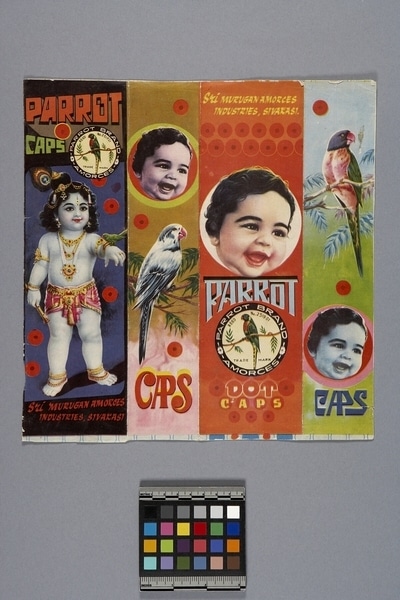Box Item Number: Eg306 from the MOA: University of British Columbia

Description
Square shaped, flattened box, consisting of four panels corresponding to the four sides to form a box. From left to right: young child, Murugan, wearing a pink and gold loin cloth; hair arranged in topknot with peacock feather stuck in it. He wears gold and jewels in hair, around neck, wrists, fingers, ankles, and waist; and red mark on forehead. A green parrot is perched on his wrist on the right. Second: baby's face surrounded by red and green circles; parrot on a branch below face. Third: baby's face encapsulated in a white circle; parrot brand trade mark below. Fourth: pink and green parrot on a branch; baby's face in red and pink circles.
History Of Use
Indian popular religious prints have been published for nearly a century, first by German presses, later by Indian ones. The prints may take the form of calendars, posters, or simply images. The style of the representations is European. In the beginning they were Hindu images, but are now acquiring elements both of folk art and a romantic secularism. It is a living art currently influenced by the movie industry and non-Hindu religions. The images are a vehicle for advertising and are also used for religious purposes. Images decorate this box for storing fireworks caps used in celebrations.
Iconographic Meaning
Peacock feather and flute are easily recognizable symbols of Krishna. His blue complexion represents the colour of endless oceans and infinite space. The flute is a symbol of the cowherds with whom he grew up. Here he is represented as balaKrishna, the playful child.
Cultural Context
popular religious art
Item History
- Made in India during 1980
- Collected before 1982
- Owned by Stephen Inglis before January 1983
- Received from Stephen Inglis (Donor) during January 1983
What
- Name
- Box
- Identification Number
- Eg306
- Type of Item
- box
- Overall
- height 28.0 cm, width 27.2 cm
Who
- Culture
- South India
- Previous Owner
- Stephen Inglis
- Received from
- Stephen Inglis (Donor)
Where
- Holding Institution
- MOA: University of British Columbia
- Made in
- India
When
- Creation Date
- during 1980
- Collection Date
- before 1982
- Ownership Date
- before January 1983
- Acquisition Date
- during January 1983
Other
- Item Classes
- works on paper
- Condition
- good
- Accession Number
- 0857/0161